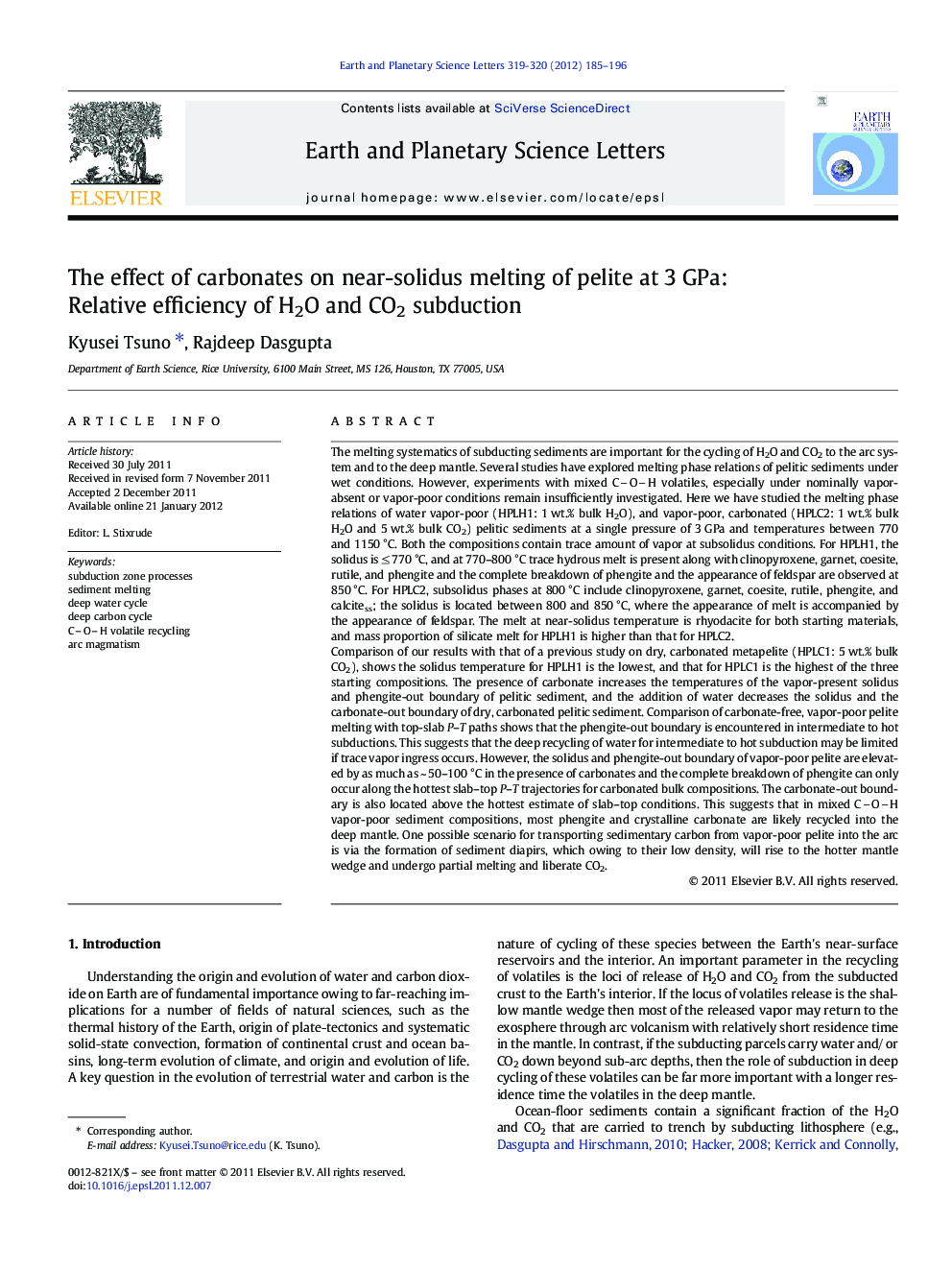| کد مقاله | کد نشریه | سال انتشار | مقاله انگلیسی | نسخه تمام متن |
|---|---|---|---|---|
| 6430704 | 1634811 | 2012 | 12 صفحه PDF | دانلود رایگان |

The melting systematics of subducting sediments are important for the cycling of H2O and CO2 to the arc system and to the deep mantle. Several studies have explored melting phase relations of pelitic sediments under wet conditions. However, experiments with mixed COH volatiles, especially under nominally vapor-absent or vapor-poor conditions remain insufficiently investigated. Here we have studied the melting phase relations of water vapor-poor (HPLH1: 1 wt.% bulk H2O), and vapor-poor, carbonated (HPLC2: 1 wt.% bulk H2O and 5 wt.% bulk CO2) pelitic sediments at a single pressure of 3 GPa and temperatures between 770 and 1150 °C. Both the compositions contain trace amount of vapor at subsolidus conditions. For HPLH1, the solidus is â¤Â 770 °C, and at 770-800 °C trace hydrous melt is present along with clinopyroxene, garnet, coesite, rutile, and phengite and the complete breakdown of phengite and the appearance of feldspar are observed at 850 °C. For HPLC2, subsolidus phases at 800 °C include clinopyroxene, garnet, coesite, rutile, phengite, and calcitess; the solidus is located between 800 and 850 °C, where the appearance of melt is accompanied by the appearance of feldspar. The melt at near-solidus temperature is rhyodacite for both starting materials, and mass proportion of silicate melt for HPLH1 is higher than that for HPLC2.Comparison of our results with that of a previous study on dry, carbonated metapelite (HPLC1: 5 wt.% bulk CO2), shows the solidus temperature for HPLH1 is the lowest, and that for HPLC1 is the highest of the three starting compositions. The presence of carbonate increases the temperatures of the vapor-present solidus and phengite-out boundary of pelitic sediment, and the addition of water decreases the solidus and the carbonate-out boundary of dry, carbonated pelitic sediment. Comparison of carbonate-free, vapor-poor pelite melting with top-slab P-T paths shows that the phengite-out boundary is encountered in intermediate to hot subductions. This suggests that the deep recycling of water for intermediate to hot subduction may be limited if trace vapor ingress occurs. However, the solidus and phengite-out boundary of vapor-poor pelite are elevated by as much as ~ 50-100 °C in the presence of carbonates and the complete breakdown of phengite can only occur along the hottest slab-top P-T trajectories for carbonated bulk compositions. The carbonate-out boundary is also located above the hottest estimate of slab-top conditions. This suggests that in mixed COH vapor-poor sediment compositions, most phengite and crystalline carbonate are likely recycled into the deep mantle. One possible scenario for transporting sedimentary carbon from vapor-poor pelite into the arc is via the formation of sediment diapirs, which owing to their low density, will rise to the hotter mantle wedge and undergo partial melting and liberate CO2.
⺠Melting experiments of pelite + H2O ± CO2 are performed at sub-arc depth. ⺠Carbonate increases the vapor-present solidus and phengite-out boundary of pelite. ⺠In the absence of carbonates, no deep flux of water may exist for hot subductions. ⺠Carbonate aids in deep recycling of phengite-bound water via sediment subduction.
Journal: Earth and Planetary Science Letters - Volumes 319â320, 15 February 2012, Pages 185-196